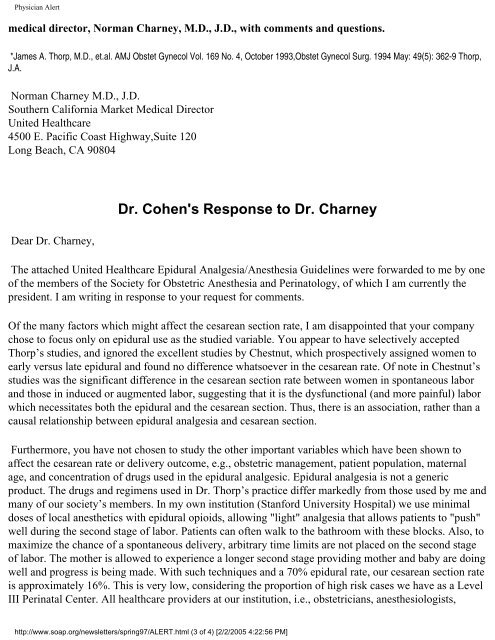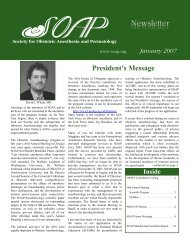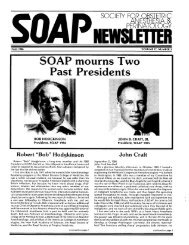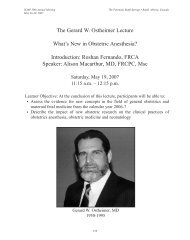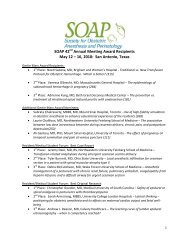SOAP Newsletter Highlights - Society for Obstetric Anesthesia and ...
SOAP Newsletter Highlights - Society for Obstetric Anesthesia and ...
SOAP Newsletter Highlights - Society for Obstetric Anesthesia and ...
You also want an ePaper? Increase the reach of your titles
YUMPU automatically turns print PDFs into web optimized ePapers that Google loves.
Physician Alert<br />
medical director, Norman Charney, M.D., J.D., with comments <strong>and</strong> questions.<br />
*James A. Thorp, M.D., et.al. AMJ Obstet Gynecol Vol. 169 No. 4, October 1993,Obstet Gynecol Surg. 1994 May: 49(5): 362-9 Thorp,<br />
J.A.<br />
Norman Charney M.D., J.D.<br />
Southern Cali<strong>for</strong>nia Market Medical Director<br />
United Healthcare<br />
4500 E. Pacific Coast Highway,Suite 120<br />
Long Beach, CA 90804<br />
Dear Dr. Charney,<br />
Dr. Cohen's Response to Dr. Charney<br />
The attached United Healthcare Epidural Analgesia/<strong>Anesthesia</strong> Guidelines were <strong>for</strong>warded to me by one<br />
of the members of the <strong>Society</strong> <strong>for</strong> <strong>Obstetric</strong> <strong>Anesthesia</strong> <strong>and</strong> Perinatology, of which I am currently the<br />
president. I am writing in response to your request <strong>for</strong> comments.<br />
Of the many factors which might affect the cesarean section rate, I am disappointed that your company<br />
chose to focus only on epidural use as the studied variable. You appear to have selectively accepted<br />
Thorp’s studies, <strong>and</strong> ignored the excellent studies by Chestnut, which prospectively assigned women to<br />
early versus late epidural <strong>and</strong> found no difference whatsoever in the cesarean rate. Of note in Chestnut’s<br />
studies was the significant difference in the cesarean section rate between women in spontaneous labor<br />
<strong>and</strong> those in induced or augmented labor, suggesting that it is the dysfunctional (<strong>and</strong> more painful) labor<br />
which necessitates both the epidural <strong>and</strong> the cesarean section. Thus, there is an association, rather than a<br />
causal relationship between epidural analgesia <strong>and</strong> cesarean section.<br />
Furthermore, you have not chosen to study the other important variables which have been shown to<br />
affect the cesarean rate or delivery outcome, e.g., obstetric management, patient population, maternal<br />
age, <strong>and</strong> concentration of drugs used in the epidural analgesic. Epidural analgesia is not a generic<br />
product. The drugs <strong>and</strong> regimens used in Dr. Thorp’s practice differ markedly from those used by me <strong>and</strong><br />
many of our society’s members. In my own institution (Stan<strong>for</strong>d University Hospital) we use minimal<br />
doses of local anesthetics with epidural opioids, allowing "light" analgesia that allows patients to "push"<br />
well during the second stage of labor. Patients can often walk to the bathroom with these blocks. Also, to<br />
maximize the chance of a spontaneous delivery, arbitrary time limits are not placed on the second stage<br />
of labor. The mother is allowed to experience a longer second stage providing mother <strong>and</strong> baby are doing<br />
well <strong>and</strong> progress is being made. With such techniques <strong>and</strong> a 70% epidural rate, our cesarean section rate<br />
is approximately 16%. This is very low, considering the proportion of high risk cases we have as a Level<br />
III Perinatal Center. All healthcare providers at our institution, i.e., obstetricians, anesthesiologists,<br />
http://www.soap.org/newsletters/spring97/ALERT.html (3 of 4) [2/2/2005 4:22:56 PM]


